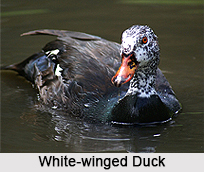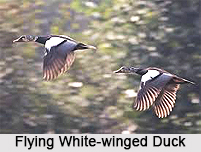 White-Winged Duck or white-winged wood duck bears the scientific name "Asarcornis scutulata" is a large species of duck, formerly placed in the genus Cairina and allied with the dabbling ducks.
White-Winged Duck or white-winged wood duck bears the scientific name "Asarcornis scutulata" is a large species of duck, formerly placed in the genus Cairina and allied with the dabbling ducks.
However, the DNA cytochrome b and NADH dehydrogenase subunit two sequence-analysis and the bio geographical pattern of distribution indicate that the anatomical similarity to the Muscovy duck is deceiving. Thus, this species might more appropriately be placed in a monotypic genus, as Asarcornis scutulata, which appears to be unrelated to the Muscovy duck but closer to the diving ducks.
Past Concentration of White-Winged Duck
White-Winged Duck was widely distributed from north-east India and Bangladesh, through South East Asia to Java and Sumatra. It is extinct in Java. In India, the duck is found only in the north-eastern part of the country with main concentration in eastern Assam and adjacent areas of Arunachal Pradesh. However, in 2002 it had a population of only 800, with about 200 in Laos, Thailand, Vietnam and Cambodia, 150 on Sumatra, notably in Way Kambas National Park and 450 in India, Bangladesh and Burma. In India, the key protected areas for the white-winged duck are Dibru-Saikhowa National Park, Dihing-Patkai Wildlife Sanctuary, Nameri National Park and Namdapha National Park. The white-winged duck occurs in dense tropical evergreen forests, near rivers and swamps.
White-Winged Duck as the Large Species of Duck
White-winged duck is one of the largest species of duck. In fact, among all wild species called duck, only the steamer ducks are larger and heavier on average. The muscovy duck also attains sizes that nearly rival the white-winged duck but may average a bit smaller in a wild state.
 Structure of White-Winged Duck
Structure of White-Winged Duck
The length of White-winged duck is 66-81 cm and wingspan is 116-153 cm (46-60 in). The males weigh 2.94-3.9 kg (6.5-8.6 lb), while females weigh 1.95-3.05 kg (4.3-6.7 lb). The most noticeable feature on adult birds, is the dark body contrasting with a whitish head and neck. Males have mostly dull yellowish bill, blackish mottling on the head and upper neck, white lesser median coverts and inner edges of tertials and bluish-grey secondaries. In flight, white wing-coverts contrast with the rest of the wings. Females are smaller and usually have more densely mottled head and upper neck. The juvenile is duller and browner.
Feeding of White-Winged Duck
This secretive species is only known to feed at night. Its diet consists of seeds, aquatic plants, grain, rice, snails, small fish and insects. It inhabits stagnant or slow-flowing natural and artificial wetlands, within or adjacent to evergreen, deciduous or swamp forests, on which it depends for roosting and nesting, usually in tree-holes. Although lowlands provide optimum habitat, it occurs up to 1,400 m of altitude, especially on plateaus supporting sluggish perennial rivers and pools.
Nesting in White-Winged Duck
White-Winged Duck tends to nest in tree cavities, and are threatened in part since the destruction of hollow trees is destroying their nesting localities. The draining of swamps and rivers and other forms of habitat destruction is also destroying the habitat that they could survive in. Additional threats include loss of genetic variability, disturbance, hunting, and collection of eggs and chicks for food or pets. Due to ongoing habitat loss, small population size, and because this duck is hunted for eggs, pets and food, the white-winged duck is evaluated as Endangered on the IUCN Red List of Threatened Species. It is listed on Appendix I of CITES. The white-winged duck is also found in the central Sumatra province of Riau, specifically in the peat land acacia plantations of a large pulp and paper company.
Habitat of White-Winged Duck
The plantations of White-winged duck at least temporarily provide suitable habitat between periodic harvests. The ducks are frequently observed along canals where large and overhanging Acacia trees provide shade and cover from predators and a haven in which to feed and rest. The quiet and still water in the canals of the plantations provides an undisturbed and secluded location, away from local communities which may hunt the ducks or collect eggs. Near-by natural forest conservation areas and greenbelts also provide suitable nesting and roosting habitat in close proximity to the canals.











